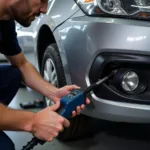Car paint scuffs are an unfortunate reality for most car owners. Whether it’s a rogue shopping cart, a careless driver, or a close encounter with a wall, these minor abrasions can mar the appearance of your vehicle. Thankfully, learning how to repair car paint scuffs is often a straightforward process that can save you a trip to the body shop. This guide will walk you through identifying the damage, choosing the right repair method, and restoring your car’s finish to its former glory.
Repairing minor car paint scuffs is usually possible at home with the right tools and techniques. Before you begin, it’s important to assess the depth of the damage. A light scuff may only affect the clear coat, while deeper scratches penetrate the color coat and require a more involved approach. Knowing the extent of the damage will help you determine the most appropriate repair strategy.
Identifying and Assessing the Damage
First, wash the affected area thoroughly with car wash soap and water. This removes any dirt or debris that might interfere with the repair process. Once clean, inspect the scuff closely in good lighting. Is it a light surface scratch or something deeper? Run your fingernail gently across the scuff. If your nail catches, the scratch is likely through the clear coat and may require more than just a simple polish. Determining the depth of the damage is the first step in deciding how to repair car paint scuffs effectively.
Repairing Light Scuffs and Scratches
For minor scuffs that only affect the clear coat, a simple polishing compound can work wonders. Apply a small amount of polishing compound to a microfiber cloth and rub it gently onto the affected area using circular motions. Gradually increase the pressure until the scuff disappears. Finish by wiping the area clean with a clean microfiber cloth. This method is usually sufficient for light scratches caused by brushing against objects or minor abrasions. For more stubborn scuffs, consider using a rubbing compound before moving to a polishing compound.
Dealing with Deeper Scratches
If the scratch has penetrated the color coat, you’ll need a more comprehensive how to repair scuffs on car paint. This might involve using a touch-up paint pen, car paint repair kit, or even wet sanding. Before applying touch-up paint, clean the area thoroughly and apply primer if necessary. Apply the paint in thin layers, allowing each layer to dry completely before applying the next. Once the paint has dried, you can use a rubbing compound and polishing compound to blend the repair with the surrounding paint.
When to Seek Professional Help
Some car paint scuffs require professional attention. Deep scratches that reach the metal or extensive damage across a large area are best left to experienced professionals. Attempting to repair such damage yourself could worsen the problem.
“While minor scuffs can be handled at home, deeper scratches often require professional expertise and specialized tools for a seamless repair,” says John Smith, Automotive Repair Specialist at Smith Auto Body.
Preventing Future Scuffs
Preventing scuffs is always the best strategy. Park carefully, avoid tight spaces, and consider using protective films or coatings on vulnerable areas. These simple precautions can significantly reduce the risk of future damage. Regular waxing can also help protect your car’s paint and make it more resistant to minor scuffs.
Conclusion
Repairing car paint scuffs can be a rewarding DIY project. By understanding the type of damage and choosing the right repair method, you can restore your car’s appearance and protect its value. However, remember that some repairs are best left to professionals. By following the tips in this guide, you can keep your car looking its best. Learn how to repair paint scuffs car effectively.
FAQ
-
Can I use toothpaste to repair car paint scuffs?
While toothpaste can sometimes remove minor surface blemishes, it’s not a recommended solution for repairing actual scuffs. -
What is the difference between rubbing compound and polishing compound?
Rubbing compound is more abrasive and used for removing deeper scratches, while polishing compound is finer and used for restoring shine. -
Do I need to apply primer before using touch-up paint?
Primer is recommended if the scratch has penetrated the color coat. -
How can I find the right color match for my touch-up paint?
Check your car’s owner’s manual or look for the paint code sticker typically located inside the driver’s side doorjamb. -
How long does it take for touch-up paint to dry?
Drying times vary depending on the product and environmental conditions, but it’s best to allow at least 24 hours for complete drying. -
Can I wax my car after repairing a scuff?
Yes, waxing after a repair can help protect the area and blend the repair with the surrounding paint. -
How do I find a reputable car paint repair crawley?
Check online reviews and ask for recommendations from friends or family.
Common Car Paint Scuff Scenarios
Parking lot mishaps, accidental scrapes against bushes, or even flying debris can lead to frustrating paint scuffs. Knowing how to quickly address these common issues can save you time and money.
Related Articles and Resources
Need help with car repairs? Contact us via WhatsApp: +1(641)206-8880, or Email: [email protected]. Our customer support team is available 24/7.

